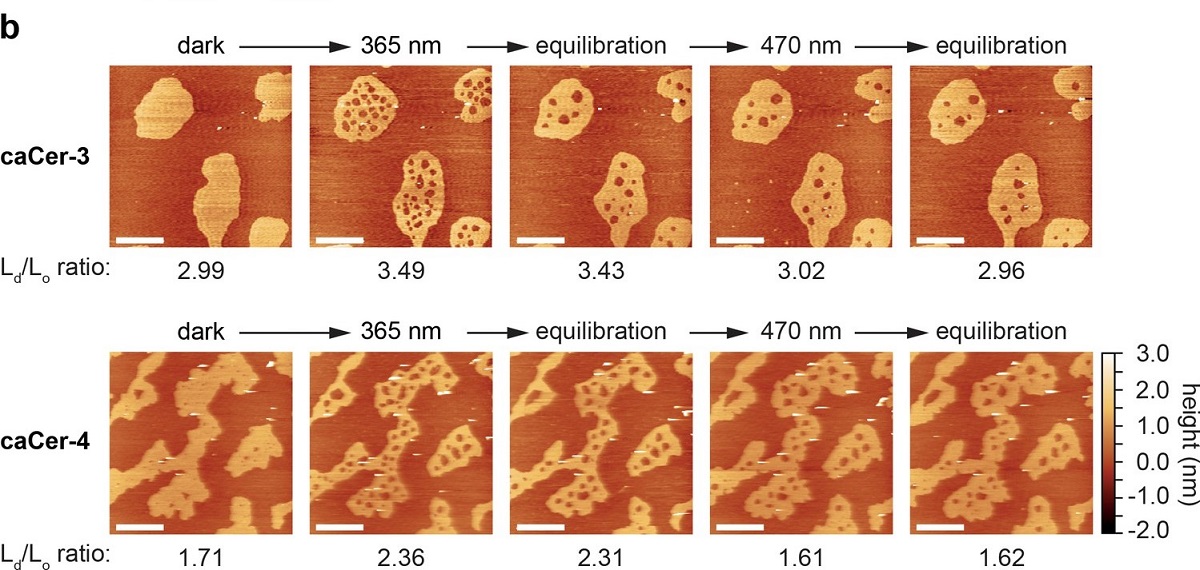Although common in nature, the self-assembly of small molecules at sold–liquid interfaces is difficult to control in artificial systems. The high mobility of dissolved small molecules limits their residence at the interface, typically restricting the self-assembly to systems under confinement or with mobile tethers between the molecules and the surface. Small hydrogen-bonding molecules can overcome these issues by exploiting group-effect stabilization to achieve non-tethered self-assembly at hydrophobic interfaces. Significantly, the weak molecular interactions with the solid makes it possible to influence the interfacial hydrogen bond network, potentially creating a wide variety of supramolecular structures.*
In the paper “Self-assembly of small molecules at hydrophobic interfaces using group effect” William Foster, Keisuke Miyazawa, Takeshi Fukuma, Halim Kusumaatmaja and Kislon Voϊtchovsky investigate the nanoscale details of water and alcohols mixtures self-assembling at the interface with graphite through group-effect. They explore the interplay between inter-molecular and surface interactions by adding small amounts of foreign molecules able to interfere with the hydrogen bond network and systematically varying the length of the alcohol hydrocarbon chain. The resulting supramolecular structures forming at room temperature are then examined using atomic force microscopy with insights from computer simulations.*
The authors show that the group-based self-assembly approach investigated in the paper is general and can be reproduced on other substrates such as molybdenum disulphide and graphene oxide, potentially making it relevant for a wide variety of systems.*
NanoWorld Arrow UHF-AuD ultra high frequency cantilevers for High Speed AFM were used for the amplitude modulation atomic force microscopy described in this paper.

Figure 4 from “Self-assembly of small molecules at hydrophobic interfaces using group effect“ by William Foster et al.:
Impact of the backbone length of primary alcohols on interfacial self-assembly on HOPG. The basic monolayer motif is visible as expected in a 50 : 50 methanol : water mixture (a), here imaged by amplitude-modulation AFM (topography image). In a 50 : 50 ethanol : water mixture (b), two organised layers are visible both in topography and in the phase where it is more pronounced, outlined by a white dashed line (blue and red arrows). In phase, the self-assembled layers appear darker than the directly exposed graphite, where no structures are present (black arrow). The lower layer shows few resolvable features and is bordered by wide rows that have a separation of 5.89 ± 0.28 nm. In 50 : 50 1-propanol : water mixture (c), novel structures with long, straight edges emerge (red arrow) and grow on top of the exposed graphite (black arrow). The structures have a row periodicity of 5.86 ± 0.25 nm. The inset shows details of the longitudinal row structures near an edge. Further variance is seen in a 50 : 50 2-propanol : water mixture (d) where two types of domains form (red and blue arrows), both demonstrating a clear phase contrast with the graphite surface (black arrow). The domains have longitudinal rows with periodicities of 6.10 ± 0.35 nm (blue arrow) and 4.91 ± 0.45 nm (red arrow). Unlike for (c), higher resolution of the row (inset) evidence curved edges. The scale bars are 50 nm in (a) and (b), 100 nm in (c) and (d) main image and 20 nm in the insets. The purple colour scale bar represents a height variation of 1 nm in (a), (b) and (d), 3 nm in (c) and 0.5 nm in the insets. The blue scale bar represents a phase variation of 1.5° in (b), 2° in (c) and its inset and 15° in (d) and its inset.
*William Foster, Keisuke Miyazawa, Takeshi Fukuma, Halim Kusumaatmaja and Kislon Voϊtchovsky
Self-assembly of small molecules at hydrophobic interfaces using group effect
Nanoscale, 2020,12, 5452
DOI: 10.1039/c9nr09505e
Please follow this external link to read the full article: https://pubs.rsc.org/en/content/articlepdf/2020/nr/c9nr09505e
Open Access: The paper « Self-assembly of small molecules at hydrophobic interfaces using group effect» by William Foster, Keisuke Miyazawa, Takeshi Fukuma, Halim Kusumaatmaja and Kislon Voϊtchovsky is licensed under a Creative Commons Attribution 3.0 International License, which permits use, sharing, adaptation, distribution and reproduction in any medium or format, as long as you give appropriate credit to the original author(s) and the source, provide a link to the Creative Commons license, and indicate if changes were made. The images or other third party material in this article are included in the article’s Creative Commons license, unless indicated otherwise in a credit line to the material. If material is not included in the article’s Creative Commons license and your intended use is not permitted by statutory regulation or exceeds the permitted use, you will need to obtain permission directly from the copyright holder. To view a copy of this license, visit https://creativecommons.org/licenses/by/3.0/.


